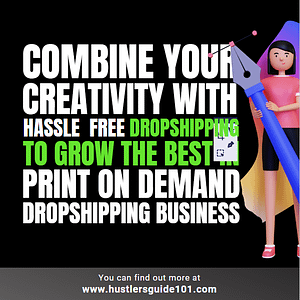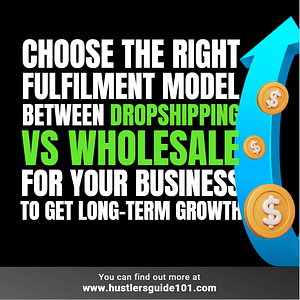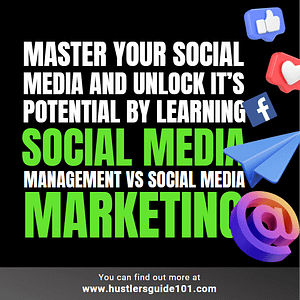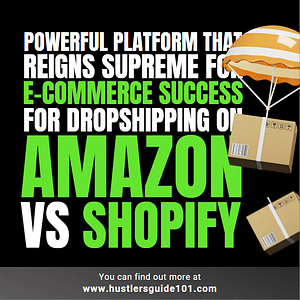
Ecommerce vs Dropshipping? Shopping online has become a global phenomenon now. I personally shop online more often than in-store. Looking at a general concept, e-commerce is more of a traditional model that involves setting up your own online store and managing inventory, shipping, and customer service.
On the other hand, dropshipping allows you to sell products without ever having to handle inventory or deal with logistical headaches.
Because the dropshipping business will take that headache for you. Both ecommerce and dropshipping have their own set of advantages and disadvantages, and understanding these differences is essential for setting your online business on the path to success.
How Ecommerce Business Model Works
E-commerce, short for electronic commerce, refers to the buying and selling of goods and services over the Internet. This business model involves setting up an online store where customers can browse and purchase products.
As an ecommerce business owner, you are responsible for sourcing and managing inventory, handling shipping and fulfillment, and providing customer support.
In the traditional ecommerce model, you act as the middleman between the manufacturer or wholesaler and the customer. Simply, you source products, purchase them in bulk, and store them in a warehouse. When a customer places an order, you pick, pack, and ship the items directly to them. Viola!
One of the biggest advantages of the ecommerce model is the control it offers. With your own online store, you have the freedom to customize the look and feel of your website, create a unique brand identity, and build a loyal customer base.
Additionally, having control over inventory allows you to ensure product quality and manage stock levels effectively.
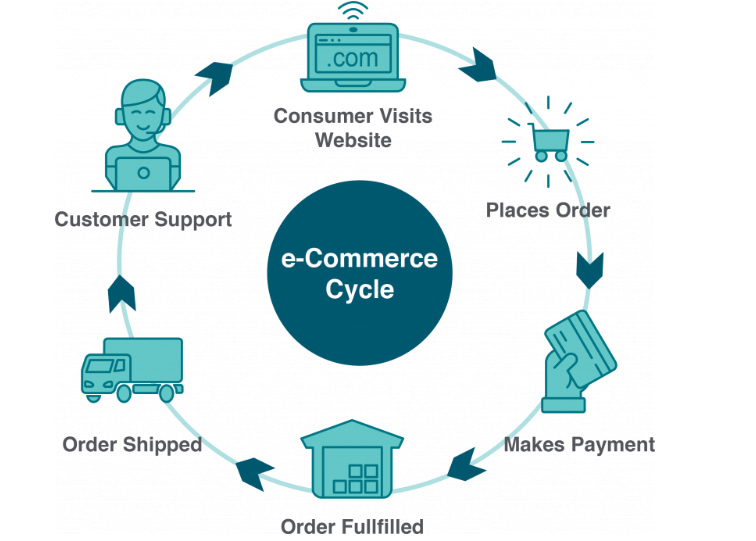
How Dropshipping Business Model Works
Dropshipping is a business model where you sell products WITHOUT actually having to hold any inventory. Instead of purchasing products upfront and storing them, you simply partner with a supplier who handles the inventory and shipping on your behalf.
When a customer places an order on your online store, the supplier fulfills the order and ships it directly to the customer. Clear enough? Saying in simple words: Dropshipping offers a more streamlined approach to e-commerce.
You essentially act as a storefront, listing products on your website without holding any inventory yourself. When a customer places an order, you forward it to a third-party dropshipping supplier, who then stores, packages, and ships the product directly to the customer.
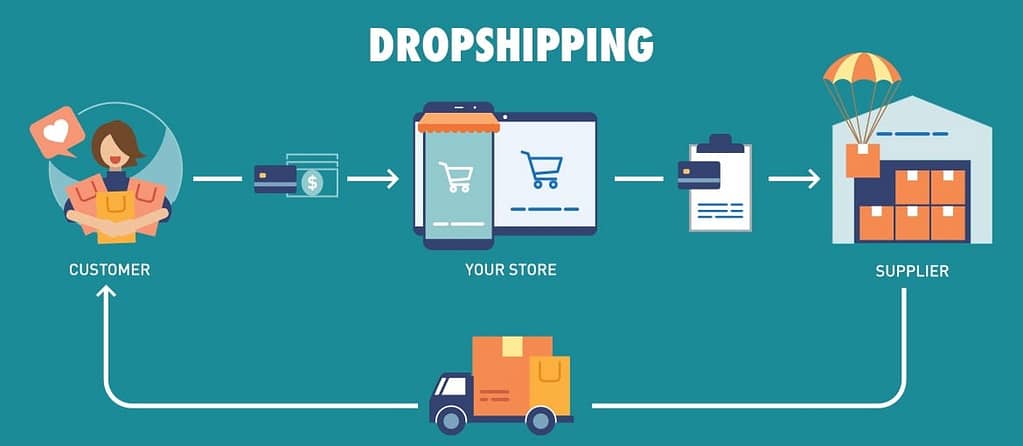
Talking about dropshipping, I would suggest going through my blog IS TEMU DROPSHIPPING PROFITABLE IN 2024?
Amazon or Shopify Dropshipping? While you are at it, you can also read this in detail to make a decision.
Key Differences in Ecommerce and Dropshipping
I have shortlisted some key differences in ecommerce and dropshipping that will help you in any business. But remember that the difference is not limited to these points, rather, your business type will decide which model is best in your case.
Initial Investment
One of the main advantages of dropshipping is the low barrier to entry. Since you don’t need to invest in inventory upfront, the initial costs are significantly lower compared to the ecommerce model. This makes dropshipping an attractive option for beginners or those with limited capital.
However, the ecommerce model also comes with its fair share of challenges. One of the main drawbacks is the upfront investment required. Setting up an online store can involve website development, hosting, and payment processing costs.
Also, managing inventory can be time-consuming and costly, especially if you’re dealing with physical products requiring storage and shipping.
Control and Management
Well, in dropshipping you can save some cash but the lack of control over product quality and shipping times may compensate your cost-free business. Since you are relying on a supplier to handle these aspects, any issues that arise can directly impact your customer’s experience.
Additionally, the profit margins in dropshipping tend to be lower compared to traditional ecommerce, as you are essentially acting as a middleman.
The dropshipping model allows for easy scalability, as you can add new products to your store without worrying about storage space.
In Ecommerce, having your own online store gives you complete control over your brand and customer experience. You have the flexibility to design your website, showcase products in a way that aligns with your brand identity, and provide personalized customer support.
Print-on-demand dropshipping? Read in detail all you want.
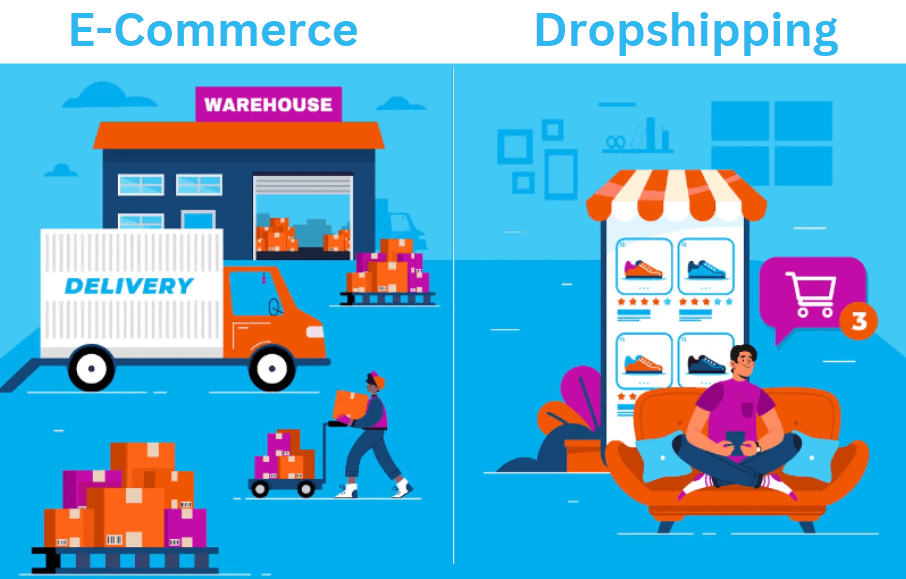
If you wanna know more about Fropshipping, Check out my blog AMAZON FBA VS DROPSHIPPING.
Return of Investment
Well, although ecommerce may feel heavy on your pocket the return on investment is worth it since ecommerce model has the potential for higher profit margins. Since you purchase products upfront and sell them at a markup, you have more control over pricing and can potentially earn greater profits.
Additionally, by managing your own inventory or machinery like t-shirt printing machines, you can take advantage of bulk buying discounts and negotiate better deals with suppliers. As for dropshipping, the profit margins tend to be lower compared to traditional ecommerce, as you are essentially acting as a middleman.
Branding and Customization
In the case of dropshipping, you have to compromise on your Branding. Sorry to say, but no dropshipping company will allow you to use your name, logo, or anything that represents you. Simply, I should say that you won’t be able to sell custom products or use unique branding i.e. freebie ideas for small businesses, customized thank you cards, or package ideas.
On the other side, in the case of Ecommerce, You have complete control over the product you sell. You can sell your own products and brand them as you wish. It helps to create a powerful brand impression, which is very important in your growth, isn’t it?
In dropshipping, If you don’t get quick sales, you have no risk as you don’t hold any inventory. By risk I mean you will not have to bear the loss, damage, or misplaced items. But, before you say whew, let me tell you that you’ll have some legal risk if the drop shipper doesn’t comply with regulations.
If things don’t sell, you’ll lose more money in e-commerce. However, since you are in charge of the entire sales process, you won’t have to handle any legal disputes with other parties.
Now you know pretty much everything about ecommerce vs dropshipping but do you know the difference between dropshipping and wholesale? Well, that’s another big talk but you shouldn’t miss if you are here to take the right decision.
Hot FAQs: Ecommerce vs Dropshipping
Can I switch from dropshipping to a traditional e-commerce model later?
Absolutely! Dropshipping can be a good way to test the market and build your customer base before transitioning to holding your own inventory.
What are some challenges of managing inventory for an e-commerce store?
Well, I think forecasting demand accurately to avoid stockouts or overstocking managing storage space, and ensuring proper product handling can bother you. Plus, implementing a system for tracking inventory levels and product movement is hard sometimes.
How do I find reliable dropshipping suppliers?
Research online marketplaces like Oberlo or Spocket, attend trade shows, or contact manufacturers directly. Look for suppliers with positive reviews, a good track record for order fulfillment, and competitive pricing.
How can I compete with other drop shippers selling the same products?
Differentiate your store through effective marketing, customer experience, and pricing strategies. To retain customers, offer excellent product descriptions, engaging social media content, and loyalty programs.
Wrapping Up: Ecommerce vs Dropshipping
In the end, I would suggest to consider the market and competition. Research the demand for your products and analyze the competition in your niche. If there is a high demand for your products and the market is not saturated, both ecommerce vs dropshipping can be viable options.
However, if the market is highly competitive and saturated, you may need to differentiate yourself through unique products or a superior customer experience.




